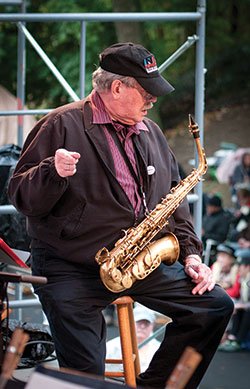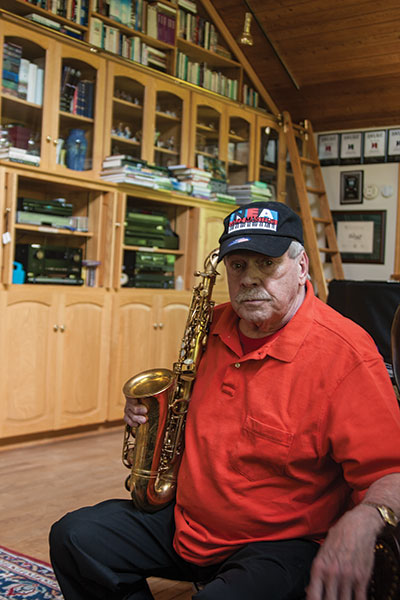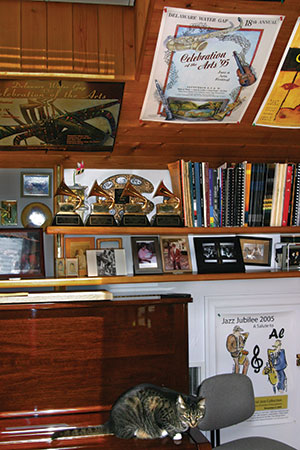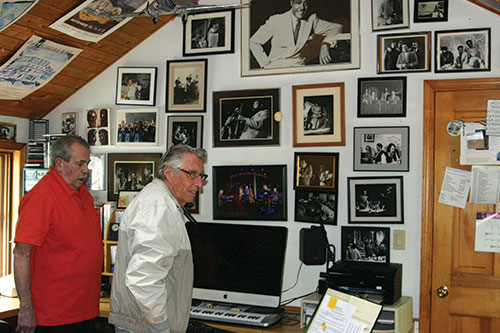Phil Woods passed away on September 29, 2015. We were fortunate to spend this time with one of the greatest jazz musicians of the modern era.

It's been fifteen years since Ed Coyne began building his latest career, that of Northwest New Jersey's foremost jazz promoter. This time he's working not for bread, but for love of the music he has followed for ninety-one years (assuming he was listening on the day he was born in Queens, NY.) He grew up listening to recordings of Louis Armstrong, and the wonderful big bands of Count Basie, Woody Herman, Stan Kenton, and Buddy Rich. Coyne experienced, live-and-in-person, what most jazz fans have only read about in books: the golden blossoming of jazz in New York City. In the clubs along 52nd Street, Ed stood "in the peanut gallery" and heard Charlie Parker, Dizzy Gillespie and all the bebop legends move America's only original art form to a new level, one which involved intense concentration to yield an equally powerful reward. Performed by small groups rather than big bands, bebop evolved almost entirely on improvisation over standard blues or "rhythm" chord changes, or the standard American songbook of the era, played by virtuoso musicians whose talents fashioned a new generation of jazz fans. "I grew up with a lot of great players," says Ed, who also played the upright bass. "Stan Getz, Gerry Mulligan, it rubs off on you!"
For years, Coyne ran a successful Manhattan advertising agency that specialized in the jewelry industry, until he moved the business to Hackettstown in 1976. With his wife, Helga, Coyne operated an upscale boutique called the Sunshine Barn on Route 57, until the mid-1990s. Ed has since returned to marketing, currently a partner in a jewelry trade publication, and promoting jazz. Since 2003, Coyne Enterprises has produced seventy-five concerts, employing more than 250 jazz musicians; greats such as David "Fathead" Newman, Houston Person, The Four Freshmen, All Star Jazz Sessions, The Artie Shaw Orchestra, Maurice Hines and the all women's Diva Jazz Orchestra. But none greater than Phil Woods, one of the finest alto saxophone players of all time, who performed at one of Ed's early Jazz in July shows at Centenary College in 2004.
Woods made himself available partly because he resides nearby, in Delaware Water Gap, PA; also because he fervently supports young local musicians, some of who accompanied him on the Hackettstown gig. If you are at all informed about American music, you know at least some of Phil's "Wiki". He came to New York from Springfield, MA in the late 1940s to live bebop, finding gracious mentors in both Parker and Gillespie. He graduated from the Julliard Conservatory in 1952: "There were no jazz schools. You went to conservatory and learned music the way they did for thousands of years. Then you pick the music you want to play. I think I'm a better musician because I learned how it works." At age twenty-three, Woods made his first recording as bandleader in 1954, since then producing more than forty-five records under his own name. The embodiment of jazz music for the past sixty years, Woods has worked as a sideman on scores of projects and recordings, from the 1956 worldwide State Department tour with Gillespie and Quincy Jones right up through his most recent recordings with Grace Kelly, the prodigious twenty-year-old saxophonist/singer/composer. (Phil says he plays Wallace Beery to her Shirley Temple.) He has won four Grammy Awards, numerous DownBeat magazine and Jazz Educator polls, Honorary Doctorate Degrees, and, in 2007, was granted a Jazz Master Fellowship by the National Endowment for the Arts, the highest honor that our nation bestows on jazz artists. Still, no matter how high his stature in the world of jazz, Phil has remained the servant of his students, and to the perpetuation of the music he loves.

When Ed invited me to come along to interview Phil Woods, I was thrilled to be in the company, not only of an artist I have long admired, but also a true jazz devotee, one who had seen it all. Phil moved to Delaware Water Gap in the mid 1970s. "I always felt comfortable here. I used to work at the Deer Head Inn when I lived in New Hope in the ‘50s. I worked at Mt. Airy when they had a singer or something, and they wanted to add a couple of saxes—Vic Damone or whoever—or hired jazz guys to play with Johnny Coates." Woods lives up the hill from the Deer Head Inn, a magnet for jazz artists since the 1940s, and where Coates became the house pianist in 1962, attracting artists like Al Cohn, Zoot Sims, Urbie Green, Keith Jarrett, Dave Tofani, Jerry Harris, Nancy Reed, and countless others; many of who still live in the area. The Woods' home is a simple Pocono house, lined with oak on the inside (good acoustics) and a very sturdy stone chimney rising up the center through the second floor loft. We sat with Phil in his living room—piano in the corner opposite bookshelves stuffed with books and sheet music rising to the roof, horn case on the fireplace step. The night before, Woods had appeared at Lincoln Center with the New York Symphony Band, a rigorous tuition-free program in symphony, chamber and jazz. "Here's this old fart, eighty-one years old with these twenty-year-olds and there's no generation gap," says Phil. "We're having a ball, I'm making a buck and we're doing good work. I would tell all that to people that want to know about jazz, and to come to our festival in the gap. We've been doing that for thirty five years, it's my only steady gig." The "festival in the gap" is the world-renown annual (weekend after Labor Day) Celebration of the Arts, (COTA), invented by Phil, trombonist Rick Chamberlain, and a bevy of other local artists, so that "musicians will be known in the Delaware Water Gap, like the trees are known. Something that is forever."
“Jazz is America’s original art form” is the classic reply. And if you don’t know anything about it, find out. Be patriotic! "
Coyne has never met Woods face to face, but when Phil's wife, Jill, comes in to say hello, she recognizes him immediately "from the Deer Head." Ed asks Phil about his most rewarding experience. "Tomorrow! I get up in the morning and I brush my tooth, give myself a round of applause, say thank you to whoever you are, and go about my business. I live my dream every day. I always go first class, I always have two seats to bring my wife or someone to help me. I stay in the best hotels and get paid to do what I would do for nothing. Don't tell anybody."

Although Woods still maintains a busy schedule of performances all over the world, he is able to spend more time composing these days. "I love writing. I'm not as fleet of foot or finger as I once was. It's getting harder to play. Emphysema is nature's way of saying you've been playing to many GD notes! I write for the band, and just finished a piece for the string ensemble in Florida. We also just finished a recording for WVIA (Pittstown, PA) Chiaroscuro label with the Festival orchestra, comprised of 99% local guys. The band won a Grammy in 80s or 90s. We can blow some of those New York guys right off the stage."
Phil notates on computer, an early adopter of software produced in the early 90s. "It saves money, there's no copyist. It nice when you can hear everything without getting a band together to read through my charts. I usually write at the piano when I get the initial idea. And then when I get the theme or some idea of where its going, then I take it to the computer. But the grunt work is always at the keyboard. Or right in this chair, just thinking about it. Sometimes I get stuck, where am I going to go with this one. Sometimes I have Eureka moments in the middle of the night "Yeah, that's what I'll do!"
Coyne: "I get ‘em (Eureka moments) on the lawn mower!"
Woods: "I think music, any kind of passion, is good when you get old. Man you gotta have something that keeps you going: hobby, profession. Life goes by so quick. Slow down!"
Coyne: "I run jazz concerts. You worked for me ten years ago. It was the first concert of a series at Centenary College. I thought I thought of everything. After the second number you turned to the audience and asked "who tuned this piano, Helen Keller?" I did everything right except the most important thing! I loved it. When you said that, I thought ‘what a way to tell me.'"
Woods: "Well, I'm glad you're still talking to me."
Coyne: "What you said about being older. This guy asked if my passion for music was helping you live longer. Absolutely! When I hear guys and it swings, it always thrills me."
Woods: "Arts are good for everybody. When they take away arts programs in the schools it infuriates me. Take away programs for the kids? I mean, you know, a kid playing a horn is less likely to buy a gun and shoot me in the ass. The jury's back: a guy that learns a little music, even as a hobby, is going to be better at whatever he decides to do in life. I mean, it's always about the buck. Can't afford the arts? You can't afford to not have the arts. I'll fight for that every day. That's why I love COTA, working with the young kids."
Coyne: "I have a major problem with the NJ Jazz Society. They give grants to students. The money needs to be spent to build an audience. So what's wrong?"
Woods: "You're eighty-six, you live in America. You know what's wrong. Three guys who live off shore own everything. They don't pay any taxes and they worked on getting all the money, and now they have it. They own our songs, our films, our culture, TV, the radio waves, energy. You know?"
Coyne: "So how do you get these generations to even think about jazz?"
Woods: "Jazz is in a lot of trouble, but thank God for the Universities. But that's not the same. I worked with DePaul University in Chicago, and they just played here at the Deer Head Inn. Did you hear that? Bob Lark is the professor, a great trumpet player. He put the kids on the bus. Took them to Cleveland, Detroit, Philadelphia, New York City, and stopped here at the Gap. Nobody goes by bus anywhere, but he wanted to show them what it used to be like so they get the real feeling for it. There's no more tours. They don't get paid at the Deer Head, they play for the door. I'm a union guy, we would never do that. But I understand it. There's no jazz business and there's no more mom and pop record labels. They're all owned by big companies who could care less, because it doesn't make money. You put on PBS and you get DooOp singers. Jazz will always exist but its becoming a fossil. Its only played on the University level, then the kids graduate and there's no gigs so they get a job teaching other kids that there's no money in this. There are thousands of students that will never make it. Now kids learn three chords, and they can't write a melody. They say jazz is old fashioned. Yeah, so is Brahms."
"Jazz started to get a little too modern; free jazz and all that.
I like expensive jazz!"
Coyne: "I ran a series for nine years at Centenary College and not one student ever came! Not one over a total of sixty-two concerts. I offered discounts, come for $5 just to get anybody under twenty."
Woods: "In Europe musicians don't have to go to work in colleges to teach. They play jazz. Every little village has a jazz festival, every town in the summer. We don't have any more jazz clubs. We're lucky to have one here. And New York City only has a few left, but it costs you $100 to go out. It used to cost $2 to get into Birdland."
When we ask Phil about his career, questions he's heard a hundred times before, he riffs back like he's answering for the first time, always with sincere generosity and a stiff dose of humor. How he first became interested in his uncle's saxophone because he wanted to melt it down for tin soldiers; enormous gratitude for his first teacher in Springfield; coming to New York to study with Lennie Tristano and meeting Charlie Parker eating cherry pie on the floor; how he became ‘the man with the hat'; years with his European Rhythm Machine; back in the States with his awesome, award-winning quintet/quartet. These are all accounts that any jazz fan should find online and read. (The 2006 interview at his Jazz Masters profile is classic.)
We ask about his horn: "I have to play every day, because there are no memory muscles in the embouchure (the use of facial muscles when playing), but its not my favorite endeavor. I like to play music but practicing is hard. Ten years ago I was getting ready to retire because I couldn't play the Selmer in tune or in the upper register anymore. A guy says ‘this guy Jim Murphy, a big fan of yours, wonders if you'd try the Yamaha.' I finally I said OK, I'll be glad to try them out. So they brought me three horns, two lacquered and one unlacquered. I tried the first one, ‘yeah it's a saxophone', second one same thing. I tried the third unlacquered one. I played one note and yelled to my wife ‘Put a hold on the retirement plans!' All of a sudden I could play all over. It gave me another ten years. I sell a lot of horns for them."
Then Phil says "Come on upstairs. You can see my wall of shame." This is paradise. On the bathroom wall, a large photo of the original Quincy Jones band in 1959 with Phil "in costume and cap." "Bud Johnson! Holy mackerel," says Ed. There's a photo from the Jazz Masters ceremony at the Kennedy Center, a document from France that made Phil a Knight, letters from U.S. Presidents, and a picture of Bird. Out in Phil's office, there's an upright piano (Yamaha, what else?) and another miniature keyboard hooked up to an iMac. The walls are lined with a whole lot more photos; a complete history of modern jazz. Posters from thirty-five years of COTA line the dormers. Shelves hold more pictures of close musician friends and family. And there's another framed photo of Charlie Parker watching over the whole room.

I'm not sure Phil takes just anybody up here, but I suspect that he knew how much Ed would appreciate it. During our talk, Phil said, "I made more money in Europe and Japan. There aren't any tours in America, even for old pros like me. They get kids cheaper. They want the smooth jazz. They don't want it too loud, they don't want it too hot, they don't want it too good. We're not for sale, but we still have to pay the rent. Is an old story, Avarice and Art. I don't have the answers but I fight the fight as hard as I can. A lot of men and women died for this music."
And there are those who live for it.
You can get Phil Woods' recordings at his website. And don't miss the annualCOTA Festival in Delaware Water Gap each fall.
Ed Coyne currently presents a series of jazz concerts at the historic Rutherfurd Hall in Allamuchy.